
December 2009 Archives

You can read the rest of the article here.An international team of physicists working in the bottom of an old iron mine in Minnesota said Thursday that they might have registered the first faint hints of a ghostly sea of subatomic particles known as dark matter long thought to permeate the cosmos.
The particles showed as two tiny pulses of heat deposited over the course of two years in chunks of germanium and silicon that had been cooled to a temperature near absolute zero. But, the scientists said, there was more than a 20 percent chance that the pulses were caused by fluctuations in the background radioactivity of their cavern, so the results were tantalizing, but not definitive.

You can read the full article here.fed by sucking small animals out of the seafloor mud with its short snout and tongue,
experts say.
Researchers say the 25 million-year-old fossil is related to today's blue whales - the largest animals on Earth.
The ancient animal's mud slurping may have been a precursor to the filter feeding seen in modern baleen whales.
These whales strain huge quantities of tiny marine animals through specialised "combs" which take the place of teeth.
The research is published in the Zoological Journal of the Linnean Society.

Lucky for us, the sharp folks at the Christian Civic League of Maine are on the case and doing all they can to protect us from this unspeakable "evil"! And as we all know, why bother substantively disagreeing with someone when you can instead publicly castigate them as an immoral pagan? After all, that's about par for the course for public discourse in America (see Joe McCarthy).Curiously, the top three shelves of this "Teenage" section offer one paranormal-themed book after another.
This section is arranged so that an unsuspecting teen is easily lured into occult literature. The first book to catch the eye is called Godless, a book apparently written to shake a young person's faith in God. Nearby is You are So Dead to Me, a novel about a teen girl's use of occult powers to control zombies.
[...]
No photos accompany this story, since the owner warned our reporter not to take pictures. For the same reason, The Record is not even running a photo of the exterior of the store.
So why is Rita Moran, the owner of the store, wary of letting the public photograph the inside of Apple Valley Books?
The answer is provided by Rita Moran herself. Moran is Chairwoman of the Kennebec County Democratic Committee. In the summer of 2007, The Record revealed that Moran is a practitioner of the occult, and participates in occult rituals at a shrine dedicated to the goddess of witchcraft.
[...]
Visitors to Rita Moran's bookstore will see that the occult is mixed in with the ordinary so as to almost be imperceptible. In the same way, the forces of darkness operate unnoticed in our civic life disguised as "marriage equality" (homosexual marriage) or "freedom of choice," (abortion) and few citizens are brave enough to call these practices what they really are - evil.

A Chicago man could be unwrapping the hundreds of Christmas gifts spread around his apartment for days, even weeks.Trouble is, they aren't really presents. They're his own belongings meticulously wrapped by friends as a prank while he was out of town.Talk about spreading holiday cheer! You can read the original article here.
Louie Saunders' packages contain everything from couch cushions to the beer in his refrigerator.
His friend Adal Rifai masterminded the scheme after Saunders gave him a spare key. It took 16 people, 35 rolls of wrapping paper and eight hours to finish the job.
Saunders tells the Chicago Sun-Times he's only been able to unwrap about 10 percent of the packages.He jokes that the upside is that, with each package he unwraps, he finds something inside that's just what he needs.


Image via Wikipedia
Santa did not become the universal Claus until 1863, when the American political cartoonist Thomas Nast, creator of the Democrat donkey and Republican elephant, rendered the quintessential Christmas icon in pen and ink.
The Bavarian-born Nast originated this archetype while working for New York's Harper's Weekly in an attempt to spiritually uplift Union Army soldiers and their families who made sacrifices during the darkest days of the bloody Civil War.



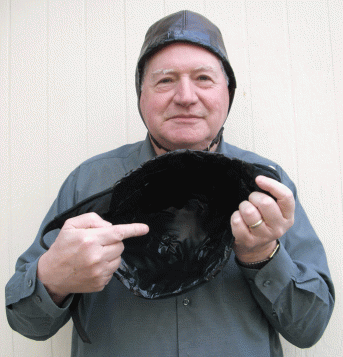
"Still nothing new to report here...so it must work!"Visit www.stopabductions.com for step-by-step instructions on how to create your own helmet and other helpful information !
"Congrats...my life has changed for the better...new job, new confidence etc."
"Thank you, thank you, for your work in this area. Your efforts to protect those of us who have been victims of this living nightmare are most appreciated."
"I am happy to report that the Thought Screen Helmet has been performing beautifully! It's been over six months now and NOT ONE INCIDENT! Aside from some of the naive neighborhood kids and their taunting it's been a blissful period."


Image via Wikipedia
Christmas's winter date was probably originally chosen to co-opt the Roman festival of Saturnalia (which, according to Wikipedia, was celebrated with similar customs (gift giving, feasting) that are done to celebrate Christmas today) or pagan European celebrations of the winter solstice. The tradition of the Christmas Tree, in fact, is considered to be closely associated with pagan traditions of tree- and nature-worship; it, too, was effectively co-opted by the Christian celebration when
St Boniface (c. 672-754) [...] cut down the tree of Thor in order to disprove the legitimacy of the Norse gods to the local German tribe. St. Boniface saw a fir tree growing in the roots of the old oak. Taking this as a sign of the Christian faith, he said "...let Christ be at the center of your households..." using the fir tree as a symbol of Christianity. [3] (from Wikipedia).This is all easy enough to swallow. Christmas altogether is complex enough to be fodder for doctoral treatises, though, and perhaps one of the most interesting aspects of Christmas is the cultural phenomenon of Santa Claus, aka Saint Nicholas, aka Father Christmas. Even when you step back to consider the "basics," Santa Claus seems bizarre. He lives in the far northern reaches of the arctic, where hundreds of elves build toys for him to deliver via flying reindeer to all the Christian children of the world. But it gets even stranger than that.
Santa Claus, of course, apparently arose from pagan traditions, too - perhaps granting some credence to the complaints of those Christians who claim that he detracts from the holiday (this argument, though, falls flat in light of the pagan origins of Christmas itself). While the kindly Saint Nicholas of Myra, a Bishop from what is now part of modern Turkey, is considered to be the original Christian inspiration for the figure of Santa Claus, Father Christmas can alternatively trace his mythological origins to Germanic pagan traditions.
Says Wikipedia:
Numerous parallels have been drawn between Santa Claus and the figure of Odin, a major god amongst the Germanic peoples prior to their Christianization.[...] Odin was sometimes recorded, at the native Germanic holiday of Yule, as leading a great hunting party through the sky.[16] Two books from Iceland, the Poetic Edda, compiled in the 13th century from earlier sources, and the Prose Edda, written in the 13th century by Snorri Sturluson, describe Odin as riding an eight-legged horse named Sleipnir that could leap great distances, giving rise to comparisons to Santa Claus's reindeer.[17] Further, Odin was referred to by many names in Skaldic poetry, some of which describe his appearance or functions; these include Síðgrani,[18] Síðskeggr,[19] Langbarðr,[20] (all meaning "long beard") and Jólnir[21] ("Yule figure").Santa Claus's history takes an even weirder turn, though: excluded from modern American conceptions of Old Saint Nick is his trickster sidekick, Krampus, who is to this day an important part of the Christmas mythology in Austria and other parts of Europe. Krampus, Santa's demon-like counterpart, frightens bad children and punishes those on the naughty list by beating them with birch rods. Wikipedia notes that "images of Krampus usually show him with a basket on his back used to carry away bad children and dump them into the pits of Hell." Closely related is the similar Dutch figure Zwarte Piet (meaning "Black Peter"), the mischievous, black-faced (from chimney soot) companion of Santa Claus who kidnapped naughty children away to Spain, where Santa apparently dwells during the off-season. Both of these figures seem to stem from traditions of vanquished demons serving noble saints, their evil turned to good through the power of Christianity. While they've largely dropped their associations with the Devil, Krampus and Zwarte Piet continue to feature prominently in European Christmas celebrations. Visiting Americans often find them off-putting, but let's be honest - are they really that much weirder than our own conceptions of Santa Claus?Image by riptheskull via Flickr
Others have even suggested an association between Santa Claus and Finnish shamans' use of psychedelic mushrooms:
In Finland, the Shamans, and one in particular called Hold Nickar, are known to have worn red suits with white spots to pick the sacred Amanita Muscaria or Fly Agaric mushrooms, which are themselves red with white spots. On returning home from picking, on reindeer sleighs, they had their mushrooms in a sack, and re entered their lodges through the smoke hole in the roof ! Hold Nickar and friends ate those mushrooms to enter the Christ Consciousness, that's how he became Saint Nickar, or Saint Nicholas as we now know him !
The reindeer also ate the mushrooms, which is why they are characterized as flying, although this ties in with other older legends of gods flying the skies at night once a year giving gifts to the worthy. (read more)
At any rate, the story of Christmas is a lot more complicated than "Away in a Manger" might have you think, and not even Santa Claus is straightforward. And we won't even get in to Space Santa:
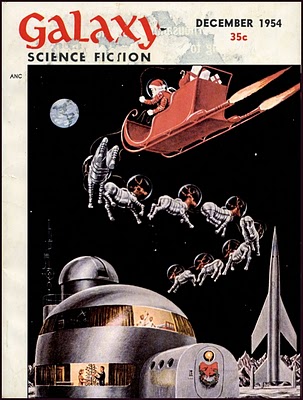
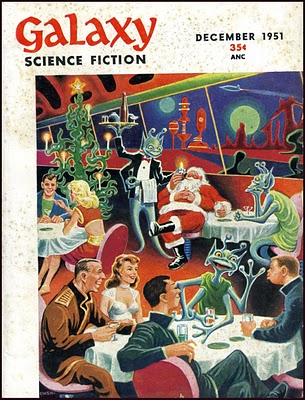
(You can see more of these at goldenagecomicbookstories.blogspot.com)

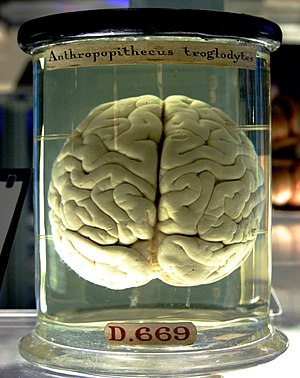
Image via Wikipedia
But even after decades of intensive research and inquiry - and centuries of dissection and speculation - the brain remains an enigma in many ways.Scientists are adopting a variety of new approaches to untangle the brain's secrets, though. Researchers at IBM are constructing a supercomputer simulation of the neocortex so detailed as to include every single neuron. Scientists at UC San Diego are painstakingly dissecting the brain of the late H.M., the famed amnesiac who participated in hundreds of memory studies, and attempting to create a "Google earth-for-brains" from his brain topology. From The New York Times:
Advanced computer technology tracks and digitally reproduces each slice [of H.M.'s brain]. An entire brain produces some 2,500 slices, and the amount of information in each one, once microscopic detail is added, will fill about a terabyte of computer storage. Computers at U.C.S.D. are now fitting all those pieces together for Mr. Molaison's brain, to create what Dr. Annese calls a "Google Earthlike search engine," the first entirely reconstructed, whole-brain atlas available to anyone who wants to log on.
"We're going to get the kind of resolution, all the way down to the level of single cells, that we have not had widely available before," said Donna Simmons, a visiting scholar at the Brain Architecture Center at the University of Southern California. The thin whole-brain slicing "will allow much better opportunities to study the connection between cells, the circuits themselves, which we have so much more to learn about."
Approaching from another angle, psychologist Dr. Russel T. Hurlburt is trying to understand the brain and the process of consciousness by creating instantaneous mental snapshots of subjects. The advanced technology he's employing to create these snapshots? Description.
Dr. Hurlburt, 64, presents the case of Melanie, a young woman who was fitted with a beeper that randomly prompted her to record everything in her awareness several times a day. In later interviews, she reconstructed these moments, often under rigorous cross-examination.
The resulting mental freeze-frames are remarkably diverse.
On the third day of Melanie's experiment, as her boyfriend was asking her a question about insurance, she was trying to remember the word "periodontist." On the fourth day, she was having a strong urge to go scuba diving. On the sixth day, she was picking flower petals from the sink while hearing echoes of the phrase "nice long time" in her head.
Whether or not these efforts will lead to valuable conclusions or advances in understanding, I can't say, but they are certainly interesting projects. In light of the year 2000 predictions about 2010, I can't help but wonder what we'll know about the brain in 2020.

Before we cede the entire moral penthouse to "committed vegetarians" and "strong ethical vegans," we might consider that plants no more aspire to being stir-fried in a wok than a hog aspires to being peppercorn-studded in my Christmas clay pot. This is not meant as a trite argument or a chuckled aside. Plants are lively and seek to keep it that way. The more that scientists learn about the complexity of plants -- their keen sensitivity to the environment, the speed with which they react to changes in the environment, and the extraordinary number of tricks that plants will rally to fight off attackers and solicit help from afar -- the more impressed researchers become, and the less easily we can dismiss plants as so much fiberfill backdrop, passive sunlight collectors on which deer, antelope and vegans can conveniently graze. It's time for a green revolution, a reseeding of our stubborn animal minds.Fair points. Vegans and vegetarians don't often acknowledge that they, too, are eating living things that "want" to live at least as much as "lower" animals. Perhaps the only morally defensible diet is Fruititarianism - that is, dining only on the parts of plants that can be removed without killing them.
[...]
"Plants are not static or silly," said Monika Hilker of the Institute of Biology at the Free University of Berlin. "They respond to tactile cues, they recognize different wavelengths of light, they listen to chemical signals, they can even talk" through chemical signals. Touch, sight, hearing, speech. "These are sensory modalities and abilities we normally think of as only being in animals," Dr. Hilker said.
At any rate, you can read the rest of Angier's article here.

# "'Smellyvision' ... technology will be available to plant microchips loaded with chemicals into our TVs so we can enjoy the aromas that go with fashion, cookery, travel and gardening." -- The People newspaper, LondonOf course, not all of the predictions were totally off the mark:
# Kids' dolls, trucks and other toys will use artificial intelligence to talk and "evolve" with your child as he grows, a process you'll be able to track dramatically with holographic photos. "Land line phones will be a thing of the past" and "there will probably be a single international currency." -- The Melbourne Herald Sun
# "Wearable computers ... will free many people from offices and ... commuting." -- PJ Wade, author, commentator, strategist and futuristAnd others, while not currently a reality, are definitely feasible and, in my opinion, ought to be implemented well before the end of the next decade:
# "Universal preschool." -- The OregonianRead the whole article here.

 !
!
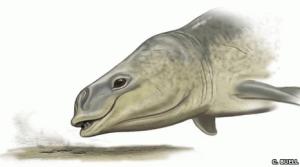
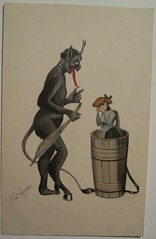
![Reblog this post [with Zemanta]](http://img.zemanta.com/reblog_e.png?x-id=1ef83179-1507-4dd0-bd95-f79fbd4ff428)
Recent Comments
Alec Defosses :
:
Good read. I saved the page for future visit. read moreShakira Furci :
:
Incredibly interesting piece of content. I was in search of read moreRitts :
:
Your site is amazing. I wonder just how do you read moreMeda Kiner :
:
I found your blog in the "Trackback" section of another read moreGale Mady :
:
The integration of bears into a godly American holiday read moreB. Samuel :
:
This information on how earth worms behave is very fascinating. read more